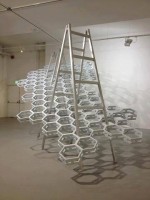ROY ANANDA
source: diannetanzergallerynetau
“For several years the influence of horror and science-fiction literature has lurked at the periphery of my practice. The most recurrent and pervasive influence seems to be the work of American pulp author Howard Phillips Lovecraft (1890 – 1937). The murky, pseudo-mythology that underpinned Lovecraft’s nihilistic tales of cosmic horror – today known as the Cthulhu Mythos – continues to be augmented and expanded upon by legions of authors, artists, gamers and fans to this day. The inventory of bizarre entities, nightmarish locales, alien artefacts and forbidden tomes that constitutes the Cthulhu Mythos grows ever larger and with R’lyeh Maquettes I find myself contributing my own portion of user-generated Mythos content.” – Roy Ananda
.
.
.
.
.
.
.
source: artgallerynswgovau
Roy Ananda is an artist, whose current work centers on speculative, process-based sculptural practice. His objects and installations reflect on the very act of making, yet are far from introspective. Rather, they lurch forth with the larger-than-life physicality of cartoons, slapstick and swashbuckling adventure. In addition to these on-going, frequently large-scale works, the artist continues to generate a body of more discreet drawings and objects that pay homage to his pop culture influences. Ananda states, ‘the qualities I strive for in my work: something daft, playful, lovingly made and idiosyncratically human.’ In addition to his studio practice, Ananda is also a writer and lecturer; he is currently Head of Sculpture at Adelaide Central School of Art.
‘Roy is a friend and fellow artist whom I’ve known for many years,’ says Deidre But-Husaim. ‘We met when we were both attending Adelaide Central School of Art and went on to share studio space for five years. Roy’s space would at times seem to become an entire installation in itself as he frequently made large-scale sculptural works. Roy’s recent series of smaller-scale works “chin supports” compelled me to create a series of paintings of him employing one of them. The particular “chin support” I used in this painting spoke to me not only of studio furniture such as the trestle table but on a more personal level about the many forms of support systems we need in life, not only physical structures but emotional ones as well: supports that keep your chin up would be wonderful to have at your fingertips whilst journeying through life and maintaining an art practice.’


